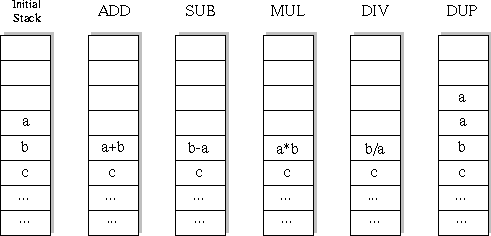Pro.ID22058 TitleOptimal Programs Title链接http://10.20.2.8/oj/exercise/problem?problem_id=22058 AC0 Submit399 Ratio0.00% 时间&空间限制描述As you know, writing programs is often far from being easy. Things become even harder if your programs have to be as fast as possible. And sometimes there is reason for them to be. Many large programs such as operating systems or databases have "bottlenecks" - segments of code that get executed over and over again, and make up for a large portion of the total running time. Here it usually pays to rewrite that code portion in assembly language, since even small gains in running time will matter a lot if the code is executed billions of times.  At the beginning of the execution of a program, the stack will contain a single integer only: the input. At the end of the computation, the stack must also contain only one integer; this number is the result of the computation. There are three cases in which the stack machine enters an error state: A DIV-command is executed, and the top-most element of the stack is 0. A ADD, SUB, MUL or DIV-command is executed when the stack contains only one element. An operation produces a value greater than 30000 in absolute value. 输入The input consists of a series of function descriptions. Each description starts with a line containing a single integer n ( n <= 10 ), the number of input/output pairs to follow. The following two lines contains n integers each: x1, x2, ..., xn in the first line (all different), and y1, y2, ..., yn in the second line. The numbers will be no more than 30000 in absolute value. The input is terminated by a test case starting with n = 0. This test case should not be processed. 输出Description As you know, writing programs is often far from being easy. Things become even harder if your programs have to be as fast as possible. And sometimes there is reason for them to be. Many large programs such as operating systems or databases have "bottlenecks" - segments of code that get executed over and over again, and make up for a large portion of the total running time. Here it usually pays to rewrite that code portion in assembly language, since even small gains in running time will matter a lot if the code is executed billions of times.  At the beginning of the execution of a program, the stack will contain a single integer only: the input. At the end of the computation, the stack must also contain only one integer; this number is the result of the computation. There are three cases in which the stack machine enters an error state: A DIV-command is executed, and the top-most element of the stack is 0. A ADD, SUB, MUL or DIV-command is executed when the stack contains only one element. An operation produces a value greater than 30000 in absolute value. Input The input consists of a series of function descriptions. Each description starts with a line containing a single integer n ( n <= 10 ), the number of input/output pairs to follow. The following two lines contains n integers each: x1, x2, ..., xn in the first line (all different), and y1, y2, ..., yn in the second line. The numbers will be no more than 30000 in absolute value. The input is terminated by a test case starting with n = 0. This test case should not be processed. Output You are to find the shortest program that computes a function f , such that f(xi) = yi for all 1 <= i <= n. This implies that the program you output may not enter an error state if executed on the inputs xi (although it may enter an error state for other inputs). Consider only programs that have at most 10 statements. For each function description, output first the number of the description. Then print out the se- quence of commands that make up the shortest program to compute the given function. If there is more than one such program, print the lexicographically smallest. If there is no program of at most 10 statements that computes the function, print the string "Impossible". If the shortest program consists of zero commands, print "Empty Sequence". Output a blank line after each test case. Sample Input 4
1 2 3 4
0 -2 -6 -12
3
1 2 3
1 11 1998
1
1998
1998
0Sample Output Program 1
DUP DUP MUL SUB
Program 2
Impossible
Program 3
Empty sequenceSource 样例输入4
1 2 3 4
0 -2 -6 -12
3
1 2 3
1 11 1998
1
1998
1998
0样例输出Program 1
DUP DUP MUL SUB
Program 2
Impossible
Program 3
Empty sequence作者 |